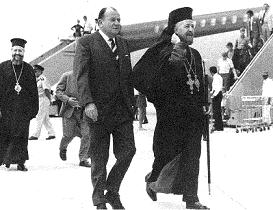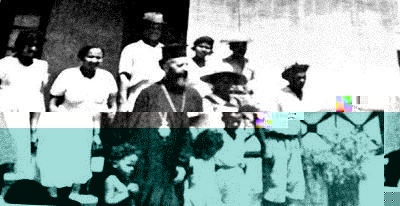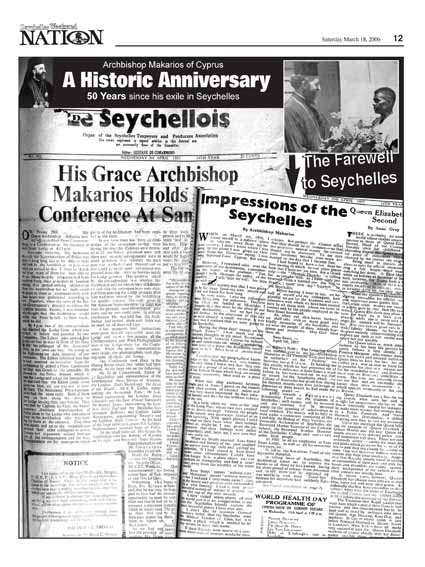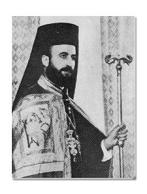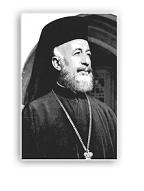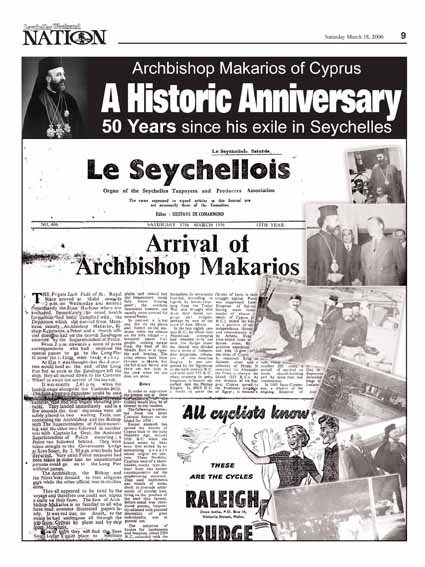Archbishop Makarios of Cyprus-A Historic Anniversary |18 March 2006
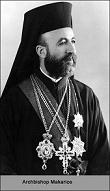
Archbishop Makarios of
50 Years since his exile in
Exactly 50 years ago, on the 14th March, 1956, the Islands of Exiles*, as Seychelles was known, at the time, received what proved to be the most famous of the all the exiles that were, ever, banished to its shores. Archbishop Makarios III, the spiritual and national leader of Cyprus together with three other Cypriot nationalist struggling for their country’s freedom from the British colonial rule, were isolated to our far away islands.
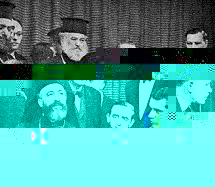
Makarios at the United Nations
Seychelles was then part of the British Empire.
Five days earlier, on the 9th March 1956, the Cypriot leader, while on his way to board a plane in Nicosia Cyprus, with the intention to fly to Athens in Greece for consultations with the Greek Government, was arrested by the colonial police and transferred to a military transport plane. He was soon to be joined by the other three arrested nationalists for a destination unknown to them. The Royal Air Force plane landed first in Aden and there after in Mombasa. From Mombasa they were transferred to a Royal Navy boat “Loch Fada” for Seychelles. Up until that point in time, the Seychelles being over a thousand miles from anywhere and only accessible by sea attracted very little publicity.
September 1972, welcomed to Seychelles by Governor Sir Bruce Greatbatch
Hence the British and before them the French used the islands as an ideal location to bring exiles from their other territories.
The voyage across the Indian Ocean lasted three days. Great was the exile’s relief when the Seychelles hove into sight.The exhausting journey was nearly over but stretching before them was the interminable monotony of exile. At 1.30 p.m. on March 14th 1956 the “Loch Fada” anchored in the straits of the Victoria harbour.The four exiles disembarked and were escorted by their British police guard to Sans Souci. This was to be their home during their months long sojourn in the Seychelles.
Last minute panic
There was panic over the accommodation arrangements for the exiles. The foreign office instructed Governor Addis to arrange secure accommodation to which he responded that arrangements had been made to place them in a large house in English River called La Bastille. This sent shivers to London due to the notorious prison connotation of the name which would add fuel to the bad international publicity over the affair. An urgent telegram ordered the Governor to find another house at all costs. The Governor having very few options at such a short notice, opted to avail his own retreat at Sans Souci and thus saved the situation, before the landing of the internees. The house became known as the Makarios House and a few years later became the residence of last resident American Ambassadors to Seychelles. This house is listed as historical by the Seychelles Government.
Seychelles on the map
The news of Archbishop Makarios’ exile travelled round the world and Seychelles was firmly on the map from then onwards as the international press reported regularly on Makarios’s exile and the four year Cypriot war of independence. The Greek press was struggling to gather information. Due to the Seychelles being so isolated and the strict security in the first few months made this task almost impossible.
Life in Sans Souci
A typical 24 hours
With some members of the staff and their children at Sans Souci
The Archbishop’s life in Seychelles developed into a routine. Unless something out of the ordinary occurred, such as an outing or a shopping visit to Victoria, he followed the same programme every day. He arose at six and before breakfast at 8 a.m., he would take a walk around the estate. After breakfast he would sit under a mango tree reading the Holy Scriptures, newspapers or perhaps a book. This would occupy him until 11 a..m., when he would withdraw to his room or tent to write or study until lunch at 1 p.m. Then followed an afternoon rest until 3 p.m., when he would take a cup of tea and then devote himself to further studies or lessons in English. Another long walk followed this period, after which the four detainees would gather together on the veranda and chat until dinner at 7.30 p.m. At 8.00 p.m. he made a point of listening to the B.B.C. news bulletin on the radio. Later, the four would retire again to the veranda for further discussions until 10p.m. when they tuned in to Athens radio for the news programme. This news bulletin was their sole contact with their homeland. And this news bulletin was very much awaited each day of their stay in Seychelles. It was all too evident that the mind of Makarios and the other internees was constantly home and the dramatic events there hence their rather melancholic look while in Seychelles. The Archbishop retired for the night at 11 p.m.
With the passing of time several events broke this routine. Such ‘incidents’ were recorded by Captain Le Geyt who while in charge of the security kept a diary that helped him write the book “Makarios in Exile”. One such incident:
The Archbishop, a keen mountaineer from his childhood days when he tented to goats at his Paphos village, was given permission to climb unescorted Morn Seychellois, Trois Freres and other mountain peaks. The understanding was that he had to return to the lodge before darkness. On one occasion he must have been lost in the tropical forest. There was great anxiety when he had not returned to base before darkness and Captain Le Geyt being in charged of his security sounded the alarm. He sent out scouts with torches but in the meantime rumors spread ….that the Archbishop escaped on a Greek submarine in Baie Lazare ! Finally Makarios assisted by his long walking stick , tired and sweating appeared at the gate to the great relief of the Captain who later confessed he was pleased that the reappearance of Makarios assured his continued employment!
This book makes a very interesting reading and contains a lot of information and events related to the exiles as viewed by a rather tolerant if not sympathetic colonial police officer. It also contains glimpses of the prevailing conditions of the then “colony of Seychelles” and of what now seems a far away era of the Seychelles in the 50’s. The book is out of stock but the National Archives treasures the only copy in Seychelles. The rules allow for reading and even photocopying but not taking outside the reading room of the Archives.
The struggle for freedom of the Exiles and of Cyprus continued
Meanwhile Cyprus was burning
With Makarios languishing in Seychelles and the unwillingness of anyone else in Cyprus to negotiate with the colonial establishment and while E.O.K.A., the armed wing of the struggle, was pursuing more daring attacks on the 35,000 strong British contingent, the situation continued to deteriorate. The Cyprus Governor Field Marshal John Harding retaliated with harsh emergency measures. A lot of men met their death with capital punishment and thousands were locked up in special prison camps. This policy however led to nowhere and in London the idea of replacing the Governor was maturing. Envoys of the British Government were sent to Seychelles and there were signs of the willingness to negotiate. A proposed plan however, the Radcliffe plan, was rejected by the Archbishop. Other plans were partitionist in nature as the British employed once again the divide and rule technique. They began inciting the Turkish minority of 18% of the population demanding partition of the island when in fact the island was totally mixed and the geographical partition made no sense at all. The results of this policy still scar the landscape in Cyprus today. Hence the U.N. resolution 541 condemning partition and the so called Turkish Republic of Northern Cyprus that is not recognized by any country other than Turkey. The drama of Cyprus continues for many years now. In fact many centuries as being in a strategic location has become the victim of many occupiers.
In Cyprus, more demonstrations, strikes, the densification of the armed struggle and the international outcry brought about their release thirteen months later. In April 1957 Makarios and the other nationalists were free to go anywhere except Cyprus. On the evening of April 5th 1957, the Archbishop and his companions gave a dinner- party in honour of the staff of the lodge. The staff were present together with their families and the Archbishop and his fellow-detainees waited upon them personally. The staff presented the Cypriots with flowers and small presents, while the Archbishop gave each of them a gratuity of £24, which was equal to a year’s wages. An Onassis tanker, the “Olympic Thunder” sailing nearby, diverted to Seychelles and took the exiles to Madagascar. At Tananarive they boarded an Air France plane to Athens where they were given a heroes’ welcome by hundreds of thousands of cheering Greeks.
Makarios continued his struggle from Athens and the negotiations brought about the independence of Cyprus in August, 1960. It was really a curtailed independence. The result was far from the target. The British retained about a hundred square miles of the island as sovereign British military bases. Thus, not only did they serve their military needs, but also secured their presence in Cyprus. Through the Treaty of Guarantee they guaranteed, together with Turkey and Greece, the constitutional order and the territorial integrity of the Republic of Cyprus. Nevertheless, Turkey invaded Cyprus in 1974, violating both, while the British remained idle. Turkey brought a terrible tragedy upon the island, with thousands of dead or wounded people, and half the population were turned into refugees in their own homeland. Turkey applied an “ethnic cleansing”, a genocide, against the Greek population of Cyprus, which constitutes 80% of the total population. Turkey has continued ever since her military occupation of almost 40% of the Cyprus territory, in violation of the relevant resolutions of the United Nations.
Makarios loved Seychelles and its people
After the first few months of strict security and tension escalating to a hunger strike on the Orthodox Easter in May, 1956, the colonial authorities allowed the exiles to periodically visit, under escort, down town Victoria.
The Archbishop became a friend of Bishop Olivier Maradan, the head of the Roman Catholic Church and Mr Gustave De Comarmond editor of the only non governmental newspaper “Le Seychellois”. On leaving Seychelles Makarios made Mr Gustave De Comarmond his representative in respect of the scholarship fund he set up. Also many other members of the community were very friendly disposed to his Beatitude. After his release he often recalled the sympathy with which he was met by the Seychellois. His feelings and impressions are reflected in his farewell statement published by “Le Seychellois” at the time of his release. In a number of interviews for many Greek and international publications and television documentaries he recalled those feelings and impressions; he had effectively become a good will “ambassador” of Seychelles and wanted to return and retire here.
In the sixties and seventies travel books used to quote his impressions:
“I have visited many places all over the world and it is no exaggeration to say that the Seychelles Islands contain the most beautiful places I have ever seen.’’
“I don’t like to question General Gordon’s belief that the Seychelles were the Biblical Garden of Eden, but it is certainly a place which is entitled by its very nature to have this name.”
“ when we finally reached Sans Souci the peace and beauty of the spot soothed my sorrow over my exile and calmed my anxieties. If I had stayed at Sans Souci under other circumstances I would have been happy. It is a place where one can meditate in tranquility and find a sanctuary away from the troubles of the outer world.”
The Makarios Fund
While in Seychelles, Makarios became aware of the financial difficulties of some the less privileged students pursuing secondary education at the fee paying Seychelles College and the Convent. In order to assist children in such predicament he set up a fund to help them. After independence the fees were abolished. However the capital of the fund which is invested in high yield Government Bonds, was increased with further contributions and started cash grants to needy students. Over 180 students from all primary, secondary and polytechnic schools, receive help every year. The Board of the fund is always chaired by the Chief Justice of Seychelles and the other members are the Catholic and Anglican prelates as well as the representative of the Archbishop of Cyprus. After the passing away of Mr Gustave De Comarmond, Mr Panos Papakokkinos, honorary consul of Cyprus, fulfilled this role. Representatives of the Ministry of Education and Social Welfare assist the Board in awarding the subvention to the students. His Grace Archbishop French Chang Him the longest serving member of the Board still is the driving force behind the good management of the Fund.
Cyprus Air Link
The first commercial flight that landed on Mahe with the opening the airport, in July 1971, came from London via Nicosia in Cyprus. Up to July, 1974 there were flights twice a week by BOAC with a Super VC-10 aircraft between Nicosia and Mahe. Prior to the termination of these flights which were ended with the closing of the Nicosia airport which was bombed during the Turkish attack on the island and more precisely in September, 1972, the Archbishop used the new link to fulfill his dream to return to Seychelles.
The going back to the Seychelles dream
In 1972 Makarios, the former exile, returned to Seychelles. This time, he was ironically received by the Governor Sir Bruce Greatbatch, while the Chief Minister Mr. James Mancham and a lot of Seychellois, welcomed him under the sound of the traditional “Kanmtole” band of “Sidonie and the Nightingales”. Among the welcoming party there were a number of staff from the Sans Souci days that had kept in touch with the Archbishop. For example, a few months earlier Makarios had received a letter from his former San Souci cook, Mr. Lebon from Foret Noir, requesting a type-writer for his daughter. This request was fulfilled however there were difficulties in clearing the parcel through Customs because it had been manufactured in Czechoslovakia and during Cold War, sometimes it was taboo to import from communist countries. This problem was resolved by the colonial Financial Secretary who allowed this gift through. Makarios enjoyed his return to the islands and bought 17 acres of prime land on mount Josephine with the intention of building a retirement home and a small church.
The invasion of his island republic and the shattering of his Seychelles dream
While the architects were busy preparing the plans for the construction of his Seychelles retreat, everything had to stop owing to the calamity that had befallen his island republic. In July 1974, a coup instigated from abroad overthrew the popular President. The conspirators failed to kill the Archbishop but as intended provided a long awaited excuse for Turkey to invade Cyprus ostensibly to restore law and order and “protect” the Turkish minority! This national catastrophe following the subsequent ethnic cleansing pursued by Turkey and the division of Cyprus, which is still ongoing today, turned the Seychelles retirement plan into an unfulfilled dream. In 1975, he briefly visited Seychelles once more while on transit from Colombo to Nairobi . After the death of the Archbishop on the 3rd August 1977, Mr. Patroclos Stavrou, a Cyprus Government official and associate of Makarios , accompanied by the sister of the late President, Maria, visited Seychelles and donated the land on mount Josephine to the Seychelles Government.
Growing Bonds
Cyprus was among the first counties who established formal diplomatic relations with Seychelles in July 1976. Over the years the historical bond between the two island nations has grown steadily.
The former Presidents Mr. Mancham and Mr. Rene as well as the former foreign ministers Mr. Maxime Ferrari and Mrs. Danielle de St George visited Cyprus. A number of Seychellois studied on scholarships in Forestry, Hotel Management and other fields. On the sporting field Cyprus provided hospitality for training the “under 17” team and the Cyprus Football Association sponsored Seychelles in a FIFA assistance scheme following a visit to Cyprus by Mr. Suketu Patel. Last year the Government of Cyprus through Ambassador Contantinos Eliades in Nairobi, the Orthodox Church and an NGO, after being approached by the Seychelles Honorary Consul of Seychelles in Cyprus Mr. Philokyprou, made contributions of cash and medicine to alleviate the affects caused by the tsunami. A growing number of Greek tourists, mainly honeymooners visit Seychelles via the Gulf.
Currently under consideration is a Double Taxation Agreement between the two countries and also the awarding of more scholarships to Seychellois students.
Cyprus now a full member of the European Union, is no longer grouped with the non aligned countries but the historical bond between the two island states is bound to always align them together.
*From the time of the first French settlement and in particular from 1767 and throughout the British rule perhaps because of the geographical location of Seychelles, hundreds of exiles were moved here. Slaves, revolutionaries and unwanted subjects from their territories elsewhere and for their so-called protection, for isolation and punishment were interned. The long list includes French political deportees from La Reunion. From mainland France, the so called Jacobins accused of attempting to kill Napoleon Bonaparte. It is also claimed but not substantiated that the Dauphin of France, Louis XVII son of Louis XVI executed during the French revolution, secretly disguised himself here. The British exercised this method with detainees from a range of countries such as Sultans from Perak, Malaysia, Somaliland, Egypt and Zanzibar. Kings from the Gold Coast, now Ghana and Uganda. Nationalist from Palestine, Ethiopia as well as other people from the Maldives, Chagos and elsewhere.
Note from the Editor:
The older generation knows a lot about Makarios and Cyprus and many people met him personally. Many people who served in the British armed forces spent time in Cyprus and the holiday camps that offered hospitality to servicemen during the World War II.
Acknowledgements:
Documentation kindly availed by the Seychelles Archives
“Makarios in Exile” By Captain Le Geyt
“President Makarios of Cyprus”
By P. Myrtiotis / R. Knight. D. Markides and D. Bailey
August 13th 1913 - August 3rd 1977
Archbishop Makarios III
Ecclesiastical Role
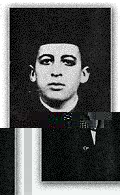

|
1926 |
1948 | 1949 |
|
|
Novice at Kykko Monarchy |
Theology student on scholarship from World Coucil of Churches, Boston University |
Bishop of Kition |
Archbishop of the Autocephalous Greek Orthodox Church of Cyprus |





